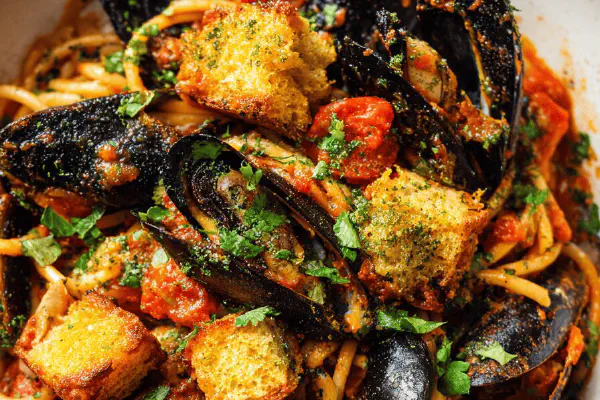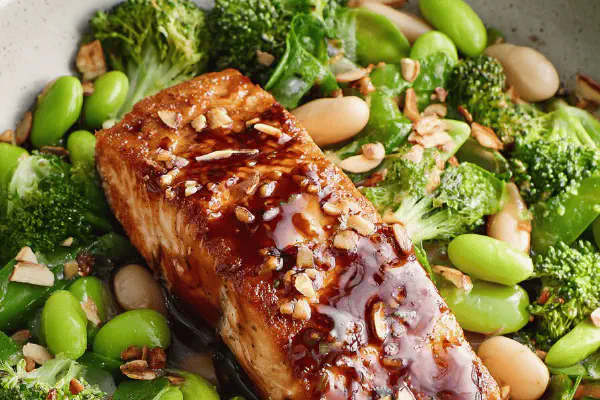Featured Recipe
One-Pot Basil Chicken Skillet

By Kate
"
Chicken thighs marinated briefly in a basil-garlic mixture. Sautéed until just opaque, then simmered with broth, fire-roasted tomatoes, and orzo pasta. Creamy finish with almond milk and shredded mozzarella. Cheese melted under a lid. A quick, rustic one-pan dinner relying on tactile doneness cues and layered flavors. Substitutions suggested for oils, dairy, and pasta types to keep the base flexible. Timing adjusted by watching liquid absorption, texture, and cheese melt rather than strict times.
"
Prep:
15 min
Cook:
25 min
Total:
40 min
Serves:
4 servings
chicken skillet
one-pot meal
Italian cuisine
quick dinner
Introduction
Quick, one-pan wonders. Chicken thighs—better for moisture and flavor over breasts. Basil pesto not just a condiment here but a marinade, infusing depth without hours of waiting. Orzo pasta in simmering broth and fire-roasted tomatoes–a rustic nod to Southern Italy. No need for separate sauce steps; cooking pasta right in the pan saves time and dishes. Almond milk softens but rounds out creaminess without heavy dairy. Mozzarella for melty topping, fresh and mild. Keep it flexible: different oils, pasta shapes, or dairy tweaks work fine. Watch textures closely. Don’t overcook chicken; still tender. Pasta al dente, not mushy. Cheese melted not burned. Smell garlic and basil early; hear bubbling as pasta cooks. Quick marination, tolerated pauses, layering of flavors. Worth mastering because it delivers every time without fuss or frantic timing.
Ingredients
About the ingredients
Chicken thighs preferred for juicy results but breasts can substitute; watch for quicker cook time and dryness risk. Basil pesto—homemade highly recommended for intense, fresh flavor; store-bought okay but check for added preservatives. Olive oil best, but avocado oil or neutral oils fine for sautéing. Garlic finely minced, avoid large chunks to prevent raw bites. Fire-roasted diced tomatoes add smoky depth; canned diced tomatoes can replace but less aromatic. Use orzo for pasta here; if unavailable, small shells or ditalini work similarly—adjust cooking slightly. Almond milk chosen for lighter creaminess—regular milk or half and half raise fat content but rich results. Mozzarella shredded; fresh mozzarella would moisten too much, harder cheeses won’t melt as easily. Salt and pepper fundamental to finish, don’t skip. Flexibility key: swap out ingredients based on pantry without losing the essence.
Method
Marinate chicken
- Toss chicken pieces with basil pesto in a bowl. Let rest at room temperature for 10-15 minutes so flavors meld but don’t overmarinate or chicken will get mushy.
- Heat skillet over medium heat, add oil. Wait until shimmering but not smoking.
- Add garlic and stir for 30 seconds until fragrant; don’t let burn or go bitter.
- Drop chicken in single layer, spread out. Sear until edges turn opaque and slightly white but center still translucent. About 4-5 minutes total.
- Pour in chicken broth and fire-roasted tomatoes with juice. Listen for gentle bubbling — that’s your simmer signal.
- Add orzo and stir quickly to submerge, distribute evenly.
- Lower heat to a gentle simmer and cover. Cook 12-15 minutes, occasionally peeking not too often. You want orzo cooked but still a bite to it (al dente) and liquid mostly absorbed but not dry.
- Lift cover, stir in almond milk. You’ll notice the sauce loosens and glistens.
- Cook uncovered 4-6 more minutes. Watch for creamy texture forming, some reduction but saucy–not watery.
- Season with salt and cracked pepper. Taste adjustments crucial here. Salt unlocks flavors; pepper adds subtle heat and contrast.
- Sprinkle shredded mozzarella evenly over skillet.
- Reduce heat to low and cover again just until cheese melts, about 3-5 minutes. No scorching cheese; steam traps moisture and aids melting.
- If cheese isn’t soft and gooey after 5 minutes, remove lid briefly and repeat, watching closely.
- Serve straight from pan for rustic feel, shred fresh basil for garnish if on hand.
Technique Tips
Avoid overcrowding the pan when searing chicken; pieces shouldn’t steam. Sear until edges lose translucency and slightly firm—white color is your guide, don’t guess times. Garlic must be fragrant but never brown or bitter—spot check after 20-30 seconds. Simmering after adding broth and tomatoes should be gentle bubbling — vigorous boil ruins texture and evaporates too quickly. Covering trap steam; during pasta cook phase don’t lift lid often but stir once halfway if liquid pools at edges. Check pasta doneness visually by biting into one piece; it should be tender yet firm (al dente). Stir in milk for creamy consistency; watch for change in sauce texture and appearance. Cheese topping—sprinkle evenly to avoid hot spots. Melting under lid uses steam gently; high heat scorches cheese or dries sauce. Season last after milk addition; liquids dilute salt intensity, so adjusting at finish prevents under or oversalting. Practice timing cues, sensory hints, and adjustments rather than strict minutes. Flexibility and attention trump timers here.
Chef's Notes
- 💡 Marinate chicken briefly. Flavor needs time, but too long makes chicken mushy. 10-15 minutes max. Watch for edges to turn opaque as cooking signals.
- 💡 Garlic is sensitive. Finely chop to prevent raw bites. Sauté for only 30 seconds until fragrant. Don’t let it brown. Add before chicken for flavor boost.
- 💡 Searing chicken — don’t overcrowd the pan. Single layer for even cooking. Look for white edges, slight firmness. Watch time but trust visual cues.
- 💡 Simmering should be gentle bubbling. Too vigorous means overshooting. Keep that liquid inside, avoid evaporation. Trust sight and sound over clocks.
- 💡 Adjust milk options. Almond milk for lighter texture keeps it creamy. Regular milk raises fat but changes the flavor. Know your preference and swap accordingly.
Kitchen Wisdom
Why chicken thighs over breasts?
Juicy and flavorful, thighs hold moisture better. Breasts dry quicker. Cook times differ, so monitor carefully.
Can I use another pasta?
Yes, small shells or ditalini work. Keep an eye on cooking time. Orzo cooks right in broth, other pastas need slight tuning.
What if the cheese doesn’t melt well?
Lower heat, cover. Steam is key. But if still hard, uncover, then watch closely. Can't scorch it.
How to store leftovers?
Cool quickly, then refrigerate. Lasts 2-3 days. Can also freeze, but texture changes when reheated. Use trouble for best results.



